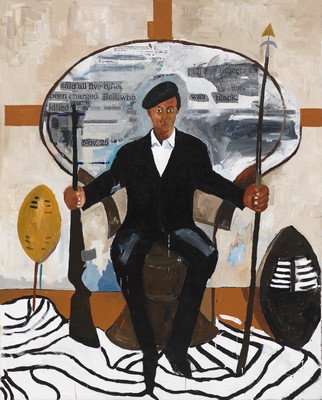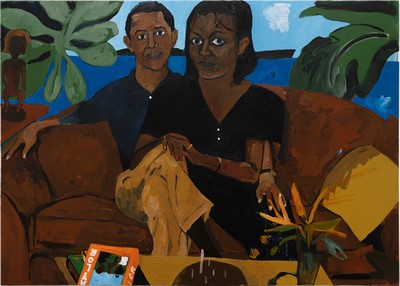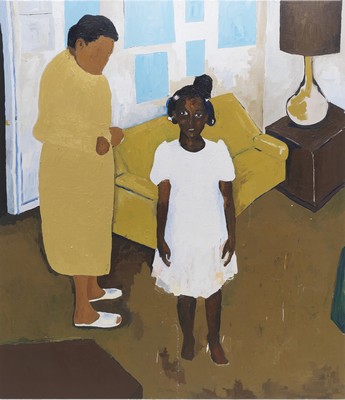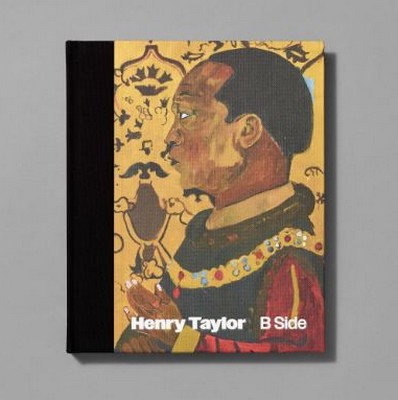Henry Taylor: B Side
Whitney Museum of American Art, New York
October 4, 2023 - January 28, 2024
i'm yours, 2015
Acrylic on canvas, 73 1/8 × 74 1/4 in. (185.74 × 188.6 cm).
Institute of Contemporary Art, Boston;
acquired through the generosity of the Acquisitions Circle.
© Henry Taylor. Courtesy the artist and Hauser & Wirth. Photograph by Sam Kahn
Huey Newton, 2007
Acrylic and collaged photocopies on canvas, 94 9/16 × 76 1/4 in. (240.2 × 193.7 cm).
Whitney Museum of American Art, New York; gift of Martin and Rebecca Eisenberg in honor of Adam D. Weinberg 2016.86f.
© Henry Taylor. Courtesy the artist and Hauser & Wirth
Untitled, 2020.
Acrylic on canvas, 60 1/8 × 84 1/8 in. (152.7 × 213.7 cm).
Private collection.
© Henry Taylor. Courtesy the artist and Hauser & Wirth. Photograph by Zachary Balber
the dress, ain't me, 2011.
Acrylic on canvas, 84 1/4 × 72 in. (214 × 182.9 cm).
Private collection; courtesy Irena Hochman Fine Art Ltd.
© Henry Taylor. Courtesy the artist and Hauser & Wirth. Photograph by Serge Hasenböhler
Homage to a Brother, 2007
Acrylic and collage on linen, 85 1/2 × 78 1/2 in. (217.2 × 199.4 cm).
The Studio Museum in Harlem; gift of Martin and Rebecca Eisenberg.
© Henry Taylor. Courtesy the artist and Hauser & Wirth. Photograph by Fredrik Nilsen
The Whitney Museum of American Art presents the landmark retrospective, Henry Taylor: B Side. As the first large-scale New York survey of leading contemporary artist Henry Taylor (b. 1958, based in Los Angeles), the exhibition celebrates the artist’s unique aesthetic, social vision, and freewheeling experimentation. Through paintings, rarely seen drawings, sculpture, and a newly conceived installation, Henry Taylor: B Side captures an over thirty-year career and features many of the artist’s most recognizable works, including paintings of family, fellow artists, legends, and public figures including Barack and Michelle Obama, JAY-Z, Martin Luther King, Jr., and more. Informed by the artist’s life experience and immediate environment, his work conveys urgency and fundamental empathy through close examination and sharp social critique.
With over 130 works, Henry Taylor: B Side is the largest exhibition of Taylor’s work to date. Though renowned for his figurative paintings, Taylor’s work encompasses many genres and a wide range of art-historical influences. Within this stylistic diversity, Taylor’s storytelling offers a juxtaposition between depictions of his family, friends, fellow artists, and the art world and his portrayal of the incarceration, poverty, and often deadly interactions with police that are disproportionality experienced by Black Americans.
“We are honored to welcome Henry Taylor back to the Whitney after his significant appearances in our Biennial and collection galleries,” said Scott Rothkopf, Senior Deputy Director and Nancy and Steve Crown Family Chief Curator. “His paintings brilliantly balance a sense of tenderness, care, and community with keen wit, pointed critique, and a sense of broad social awareness.”
This exhibition was originally organized by the Museum of Contemporary Art (MOCA) in Los Angeles, and curated by Bennett Simpson, Senior Curator, with Anastasia Kahn, Curatorial Assistant, at MOCA. The presentation at the Whitney Museum of Art is organized by Barbara Haskell, Curator at the Whitney, with Colton Klein and Caroline Webb, Whitney Curatorial Assistants.
“Henry Taylor is guided by his deep-seated empathy for people and their histories,” says Barbara Haskell. “Painted with kinetic intensity from memory, newspaper clippings, snapshots, and in-person sittings, his portraits capture the humanity, social milieu, and mood of his subjects. They combine flat planes of vibrant, saturated color with areas of rich, intimate detail and loose brushstrokes to create paintings that really feel alive.”
Organized thematically, Henry Taylor: B Side highlights several of the artist’s major subjects. Among them are his family members and artistic community, street scenes from Los Angeles and beyond, icons of politics, literature, sports, and the music world, and encounters with anti-Black racism, policing, and American history. In addition to paintings, the exhibition features a new installation created specifically for the Whitney, a selection of Taylor’s assemblage sculptures, rarely seen early drawings, and a large grouping of his “painted objects,” which include pointed observations rendered on recycled cigarette packs, cereal boxes, and other everyday objects.
Henry Taylor: Legends
Historically, portraits have been used to communicate authority, achievement, and social standing. Taylor’s depictions of iconic figures within the Black community who have achieved significant political, artistic, or athletic success are in this tradition. Works like I Am a Man (2017) and It's H. I. M. (2012) are powerful visual symbols of Black accomplishment and aspiration. In honoring his subjects, Taylor points to their ambition and overcoming that have inspired his own life.
Henry Taylor: Social Critique
Within Taylor’s subject matter are numerous works that delve into political and social allegory and current events. In some, he addresses actual events in ways that can be terrifyingly direct but also suggestive of daily reality. Several paintings memorialize young men murdered by the police, while others reference the United States penal system through images of prison walls, guard towers, and citizens with their hands up. Works like THE TIMES THAY AINT A CHANGING, FAST ENOUGH! (2017), which was part of the 2017 Whitney Biennial, That Was Then (2013), and Warning shots not required (2011) extend a long tradition of socially charged paintings marking moments in history and signaling an emotional message of outrage and grief.
Henry Taylor: Family Portraits
Henry Taylor returns repeatedly to his most familiar subjects—his mother, father, siblings, aunts, uncles, cousins, and three children. In 1944, Taylor’s parents moved from the East Texas town of Naples to Oxnard, California, making them among the millions of Black Americans who left the South in the mid-twentieth century as part of the Great Migration. Their experiences, and the stories he heard from them growing up, instilled in Taylor a sensitivity to the cultural and political currents that affected his community. Painted from memory, during in-person sittings, or from snapshots, works like i'm yours (2015), Cora, (cornbread) (2008), The Love of Cousin Tip (2017), and the dress, ain't me (2011) form a continuum with the figurative paintings of earlier artists such as Bob Thompson, Alice Neel, and Philip Guston.
Henry Taylor: Camarillo and CalArts
From 1984 to 1995, Taylor worked as a psychiatric technician at the Camarillo State Mental Hospital, caring for adults with developmental disabilities and mental illness as well as those seeking substance abuse treatment. Taylor's rarely seen pencil sketches of patients in the psychiatric ward during this period are among his earliest artworks. Among these “Camarillo Drawings,” many include quotes from the sitters or notes from Taylor’s own stream-of-consciousness. Taken as a whole, the sketches reveal Taylor’s empathetic observation of physical and psychological states—hallmarks of his work in general. While working the night shift at Camarillo State Mental Hospital, Taylor was also a student at Oxnard Community College (1985–1990) and the California Institute of the Arts (1990–1995). The paintings he made during this period merge his sensitivity to emotional states with bold color and the vocabulary of popular culture, particularly comic strips.
Henry Taylor: Downtown LA
After graduating from CalArts in 1995, Taylor moved to downtown Los Angeles where he developed a significant rapport with his community. Some he would invite into his studio to have their portraits painted; others he depicted using intimate, informal snapshots. In more recent years, Taylor’s extensive international travels have provided an equally rich source for his street scenes. Works like Fatty (2006), Too Sweet (2016), and emery lambus (2016) showcase Henry Taylor’s extended community through images that capture each subject’s humanity and personality.
Henry Taylor: Painted Objects
In the early 1990s, Henry Taylor began treating commonplace materials like cigarette cartons, butter containers, and cereal boxes as painting surfaces. Often he would trade or sell these works to his neighbors and fellow artists. Executed quickly, these small-scale, painted cardboard objects function like sketches, providing an inexpensive way for Taylor to work out compositional and thematic ideas and to experiment with language, text, and abstraction.
Henry Taylor: Artists / Art World
Taylor’s portraits of artists, critics, and curators comprise a significant thread running through his work. Among his portrait subjects are a number of artists whose work is in the Whitney Museum collection, including Andrea Bowers, Deana Lawson, and Robert Pruitt. Taylor’s personal network is joined by a collection of art-historical influences that Taylor invokes by reinterpreting or “covering” their art just as a musician would in performing a remix or adaptation of a previously recorded song. Works like Before Gerhard Richter there was Cassi (2017), Hammons meets a hyena on holiday (2016), and Portrait of Kahlil Joseph (2019) map Taylor’s social and artistic circles and influences to suggest the range of styles and periods.
HENRY TAYLOR was born in Ventura, California, in 1958 and grew up in nearby Oxnard. While studying art at Oxnard Community College from 1984–1990 and the California Institute of the Arts (CalArts), he worked on the night shift at Camarillo State Mental Hospital as a psychiatric technician. After graduating from CalArts in 1995, he moved to downtown Los Angeles where he became a mainstay of that area’s burgeoning art community. While continuing to maintain studios in downtown Los Angeles, Taylor has in more recent years traveled and painted widely in New York, the Caribbean, and Africa, extending the international scope of his career. In 2017 Taylor’s work THE TIMES THAY AINT A CHANGING, FAST ENOUGH! (2017), was featured in the seventy-eighth installment of the Whitney Biennial, the longest-running survey of American art.
An accompanying exhibition catalogue, Henry Taylor: B Side, was co-published by The Museum of Contemporary Art, Los Angeles, and DelMonico Books and distributed by ARTBOOK | D.A.P. . Edited by Bennett Simpson, the catalogue features contributions by Wanda Coleman, Karon Davis, Charles Gaines, Harmony Holiday, Bob Kaufman, Walter Price, Bennett Simpson, and Frances Stark, along with a conversation between Henry Taylor and Hamza Walker. The publication includes illustrations of nearly three decades of Taylor’s work in all media. Copies is available for purchase online and in the Whitney Shop ($60).
Whitney Museum of American Art
99 Gansevoort Street, New York, NY 10014






